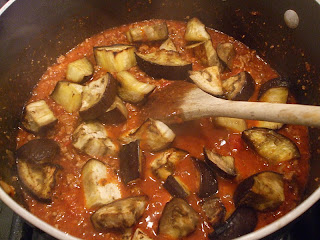By now, you will probably have noticed my love of stew. It's not just it's 'one pot' appeal, it's also one of the most comforting meals you can bring to the table in my opinion. Its smell slowly creeps through the house as it cooks, it's the meal you can plonk in the middle of the table and allow everyone to dig in, and, well, it just puts a smile on my face and makes me content every time I make one. In search of happiness as I am, I love finding and trying out new stews, especially ones that are rustic, peasanty and rich in taste and hopefully not in cost.
My love of beef stew and the vigorous heat of black pepper led me to this recipe, again from Bocca by Jacob Kenedy. I halved the recipe I am about to give you and bulked the meal out with mashed potato and green beans. I think cannellini beans and crusty bread would be great too and possibly a more authentic Italian accompaniment. I concur with Kenedy when he says that leftovers would make a good sauce when mixed with pasta. The two pasta monsters who inspire my food musings would no doubt agree.
If you are concerned about the effect of the peppercorns on the taste of the stew, you'll be pleased to know that they give the stew an edge rather than dominant peppery taste. It is more side show rather than main event.
Peposo, or Beef and Peppercorn Stew, adapted from Bocca by Jacob Kenedy
Serves 4 as a main
Ingredients
80ml extra virgin olive oil
1kg braising beef; (I used flank) cut into chunks
2 onions, diced
4 garlic cloves, chopped
25 whole peppercorns
15g coarsely ground black pepper
250ml red wine (open one that you intend to drink with the meal, and if you're me, pour yourself a glass to have whilst cooking)
1 bay leaf
1kg tinned tomatoes. (I used tinned cherry tomatoes).
Method
Heat the oil in a heavy bottomed stewing pan or something similar.
Season the meat well with salt and brown well over a medium heat - about 15 minutes.
Add the onion and garlic and cook for another 10 minutes or so, stirring occasionally, until they are well softened.
Add the whole black peppercorns, ground black pepper and bay leaf and fry for a minute or so before adding the wine and tomatoes. Taste for seasoning and then bring to a simmer, then reduce the heat and cook, lid on, for 1 and a half hours until the meat is tender. Taste again for salt and adjust accordingly.




















































